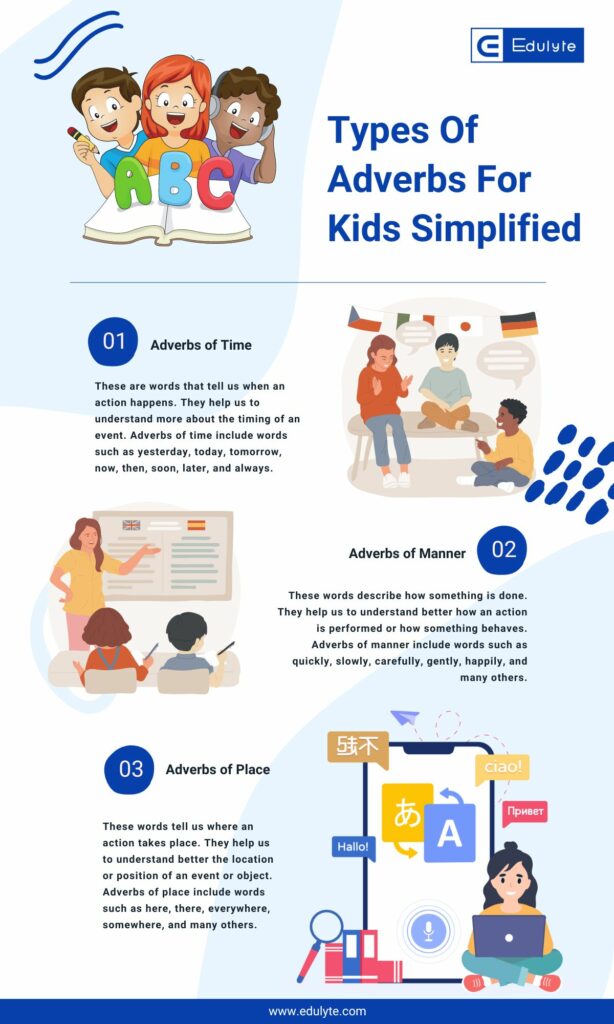
Noun
Phonetics:
naʊn
Pronunciation:
The Building Blocks of Language: Exploring Nouns in Grammar
Comprehensive Definition, Description, Examples & Rules
What is a noun definition? Understanding nouns is essential for effective communication, whether you’re an English language learner or a parent supporting your child’s language development. With Edulyte’s English mentors, you can become a pro at nouns and avail free English language resources. Explore this page to learn how!
Introduction to Nouns
Nouns are essential in language because they help us identify, name, and describe people, places, and things. We apply nouns in our everyday communication. They are the words we use every day to express ourselves. It’s like the glue that holds our sentences together!
Types of Nouns
Now that we understand the noun’s meaning and significance of nouns, let’s explore the various types in more detail and the noun list for each type of noun.
Common Nouns
Common nouns are the everyday words we use to refer to general people, places, or things. For example, “dog,” “city,” and “book” are all common nouns. These nouns only require capitalisation if they appear at the beginning of a sentence.
Proper Nouns
Proper nouns are specific names for individuals, places, or things. They always begin with a capital letter, regardless of their position within a sentence. For example, “John,” “London,” and “Eiffel Tower” are all proper nouns.
Differentiating Common Nouns from Proper Nouns:
It’s essential to understand the difference between common nouns and proper nouns. Common nouns are general, while proper nouns are specific names given to individuals, places, or things. For instance, “dog” is a common noun, whereas “Rover” is a proper noun referring to a specific dog.
Capitalisation Rules for Proper Nouns:
Remember to capitalise the first letter of each word to use proper nouns
correctly. For instance, “United States of America” is a proper noun, and each word is capitalised.
Concrete Nouns
Concrete nouns represent tangible objects and physical entities. They include things we can see, touch, hear, smell, or taste. For example, “tree,” “car,” and “music” are all concrete nouns.
Sensory Descriptions and Experiences:
Concrete nouns allow us to communicate sensory details and experiences. We can use concrete nouns to describe an object’s colour, texture, or sound, making our language more vivid and engaging.
Abstract Nouns
Abstract nouns refer to ideas, concepts, qualities, or emotions that are intangible and non-physical. They represent things that cannot be perceived through the senses but as mental or emotional constructs. Examples of abstract nouns include “love,” “happiness,” and “freedom.”
Non-Tangible and Intangible Qualities:
Abstract nouns help us describe qualities or concepts that cannot be touched or seen but are crucial for understanding and expressing our thoughts and emotions.
Countable Nouns
Countable nouns are objects or entities that can be quantified and counted. They have both singular and plural forms. Examples of countable nouns include “book,” “child,” and “apples.”
Singular and Plural Forms:
Countable nouns have singular forms when referring to one object and plural forms when referring to more than one.
Uncountable Nouns
Uncountable nouns,
or mass nouns, are substances, ideas, or concepts that cannot be counted individually or have no plural form. Examples of uncountable nouns include “water,” “information,” and “happiness.”
Indefinite and Mass Quantities:
Uncountable nouns cannot be expressed as discrete units or counted individually. Instead, they represent indefinite quantities or continuous substances.
Collective Nouns
Collective nouns refer to groups, collections, or assemblies of people, animals, or things. They represent a single entity made up of multiple members. Examples of collective nouns include “family,” “herd,” and “team.”
Singular and Plural Agreement:
When using collective nouns, it is vital to ensure subject-verb agreement. For example, we say, “The team is playing” (singular agreement), but “The team are celebrating their victory” (plural agreement).
Compound Nouns
Compound nouns are formed by combining two or more words to create a single noun. Examples of compound nouns include “self-esteem,” “keyboard,” and “post office.”
Hyphenated and Open Compound Nouns:
Compound nouns such as “self-esteem” can be hyphenated or written as one word, such as “keyboard.” Some compound nouns are open and separated by spaces, like “post office.”
Possessive Nouns
Possessive nouns indicate ownership or relationships between people, places, or things. They are formed by adding an apostrophe and “s” (‘s) to the noun. For example, “Mary’s book” indicates that the book belongs to Mary.
Examples of Nouns
Nouns are incredibly versatile and encompass many words that serve as naming words for people, places, and things. Let’s dive deeper into some examples of nouns and explore how they are used in different contexts.
Nouns as Naming Words for People, Places, and Things:
Nouns are crucial in identifying and naming people, places, and things. Here are some examples of nouns in each category:
People:
- – Man
- – Woman
- – Teacher
- – Doctor
- – Artist
Places:
- – City
- – Park
- – School
- – Beach
- – Restaurant
Things:
- – Book
- – Chair
- – Car
- – Table
- – Computer
These nouns enable us to refer to specific individuals, locations, and objects, allowing for clear and precise communication.
Identifying Nouns in Sentences:
Identifying nouns in sentences is an essential skill that helps us understand sentence structure and meaning. Let’s look at some examples:
- – The dog barks loudly.
- – John enjoys playing basketball.
- – She bought a new dress.
- – They visited the museum yesterday.
- – That is Mary’s car.
- – The book belongs to the student.
Nouns in Different Contexts:
Nouns can take on various meanings and connotations depending on the context in which they are used.
Abstract Nouns in Emotional Context:
- – Love is a powerful emotion.
- – The poet expressed his innermost feelings through his words.
Concrete Nouns in Descriptive Context:
- – The beach is adorned with soft, golden sand and crystal-clear water.
- – The toddler played joyfully with his colourful toys.
Proper Nouns in Geographic Context:
- – London is a vibrant city with rich history and culture.
- – My dream is to visit the Taj Mahal in India.
Noun Cases and Functions
Nouns have different roles within sentences and can function as subjects, objects, possessors, or elements of prepositional phrases. Cases of nouns deals with all these functions. Let’s take a closer look at their cases and functions.
Subject Nouns:
Subject nouns are the focus of a sentence and perform the action or state of being. For example, in the sentence “John runs,” “John” is the subject noun.
Object Nouns (Direct and Indirect Objects):
Object nouns receive the action or indicate the recipients of the action in a sentence. For instance, in the sentence “Sarah gave John a book,” “John” is the direct object noun, and “Sarah” is the indirect object noun.
Noun as the Possessor (Genitive Case):
Nouns in the possessive form indicate ownership or relationships between people, places, or things. For example, in the sentence “My sister’s car is blue,” “sister’s” shows possession.
Nouns in Prepositional Phrases:
Nouns can function as the objects of prepositions, providing additional information about location, time, or direction. For instance, in the phrase “in the park,” “park” is the noun in the prepositional phrase.
Noun Forms and Inflections
Nouns can change forms to indicate singular or plural, gender, and possessiveness. Let’s explore these inflections.
Singular and Plural Nouns:
Nouns can have singular forms (referring to one) and plural forms (referring to more than one). Regular plural nouns typically add
“s” or “es” to the singular form, while irregular plurals follow different patterns.
Irregular Plural Nouns
These nouns do not follow the same rules as regular nouns. They do not become plurals by adding “-s” or “-es”. Examples: “party” becomes “parties”, “man” becomes “men”.
Noun Gender and Pronouns:
Some nouns have gender distinctions, such as “actor” (male) and “actress” (female). Pronouns can replace nouns to avoid repetition and maintain clarity.
Noun Derivations:
Nouns can be derived from other parts of speech, such as verbs or adjectives, through various suffixes or changes in word formation. For example, “happiness” is derived from the adjective “happy” by adding the “-ness” suffix.
Applying Nouns in Writing and Communication
Nouns play a vital role in effective writing and communication.
Using specific nouns enhances our writing by providing clear descriptions and avoiding ambiguity. Instead of saying “animal,” we can be more precise and say “lion” or “elephant.”
Nouns help us vary sentence structure, making our writing more engaging and dynamic.
Understanding the capitalisation rules for proper nouns ensures accurate usage and conveys respect for specific names.

Transform Your English Skills
Free sign-up for a personalised dashboard, learning tools, and unlimited possibilities!
Sign up Now
Key Takeaways
- Nouns are essential in sentence structure and language.
- Types of nouns include common, proper, concrete, abstract, countable, uncountable, collective, compound, and possessive nouns.
- Proper nouns are specific names, while common nouns are general.
- Concrete nouns are tangible, and abstract nouns represent ideas.
- Countable nouns have singular and plural forms.
- Collective nouns refer to groups.
- Compound nouns are combinations of words.
- Possessive nouns show ownership.
Quiz
Question comes here
Frequently Asked Questions
Examples of proper nouns include names of specific people, such as “John Smith”, “Mary Johnson”, “Paris,” “Mount Everest,” or “Disneyland.”
Countable nouns are objects or entities that can be counted and have singular and plural forms. Examples of countable nouns are “book” (singular) and “books” (plural). Uncountable nouns refer to substances, concepts, or qualities that cannot be counted individually. Examples include “water,” “love,” or “information.”
To make nouns plural, you usually add “-s” or “-es” to the end of the singular noun. For example, “book” becomes “books,” and “box” becomes “boxes.” There are exceptions to the rule, such as “child” (singular) becoming “children” (plural)
Abstract nouns refer to ideas, concepts, emotions, or qualities that are intangible and cannot be perceived through the five senses. Examples of abstract nouns include “love,” “happiness,” and “freedom.”
Collective nouns are words used to describe a group or collection of people, animals, or things. Examples: “family,” “team,” and “herd.”
Possessive nouns show ownership or a relationship between two things. For example, “the dog’s bone” indicates that the bone belongs to the dog, and “the students’ books” shows that the books belong to the students.
The main types of nouns in English grammar include common nouns, proper nouns, concrete nouns, abstract nouns, countable nouns, uncountable nouns, collective nouns, compound nouns, and possessive nouns.
Proper nouns are specific names of people, places, organisations, or things. They are always capitalised to distinguish them from common nouns. Capitalising proper nouns helps identify and give importance to specific entities in written communication.
Nouns are crucial in providing clarity, specificity, and descriptive power to writing and communication. Using appropriate nouns allows writers to effectively convey their ideas, create vivid descriptions, and engage readers. Nouns add depth and richness to language, making it more expressive and engaging.


